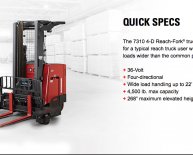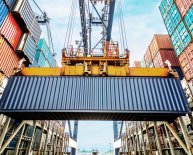
Bendi Forklifts Australia
The conventional four-wheel counterbalance is the most widely used type of pallet stacking device the world over because its original design is practical, versatile and cost-effective. The truck does, however, require a lot of space relative to the size of load and 4m - 5m aisles are not uncommon.
3 wheeled counterbalance trucks were designed to reduce the stacking aisle to approximately 3m. In general these machines, whilst a more cost effective alternative, lift less weight and are less able to work on rough terrains, so they are more associated with internal warehousing and minimal yard work.
Reach trucks have a mast or forks that 'reach in or out' from the body of the truck to further reduce aisles and can work in aisles from 2.6 - 3m wide offering a valuable saving. To enhance the aisle performance, reach trucks are designed in a compact manner and this necessitates harder tyres to overcome stability issues resulting from the high centre of gravity. These smaller, harder tyres dictate that the reach truck is only suitable for inside work or very smooth yards. More often than not a counterbalance truck is required to load vehicles from the warehouse.
VNA (very narrow aisle) trucks are capable of working in 1.7 - 2m aisles making the maximum use of storage space. This is the area in which designer Freddy Brown was responsible for many developments prior to designing the original Bendi articulated truck.
Due to the close tolerances within the VNA aisle, a number of criteria have to be fulfilled. Expensive floors with very fine tolerances are required to meet the flatness required by VNA machines. Rail or wire guidance is used to enable the truck to be millimetre perfect whilst travelling up and down the aisle and this guidance adds significant cost. Ironically, large spaces (transfer aisles) measuring 4 - 6m at the end of each aisle are required to allow the VNA trucks to transfer from one aisle to the next which wastes valuable storage space and is a slow process. This type of truck is also only suitable for in aisle operation which means that other more conventional trucks are required to feed the VNA system and take goods away. Every VNA truck is tailor-made for each warehouse, product and racking system which means that the product can't vary too much and the trucks cannot easily be relocated. Short term hire or replacement in the event of a breakdown is virtually impossible to find. For many companies this inflexibility combined with the operational costs limits the size of the VNA marketplace.















